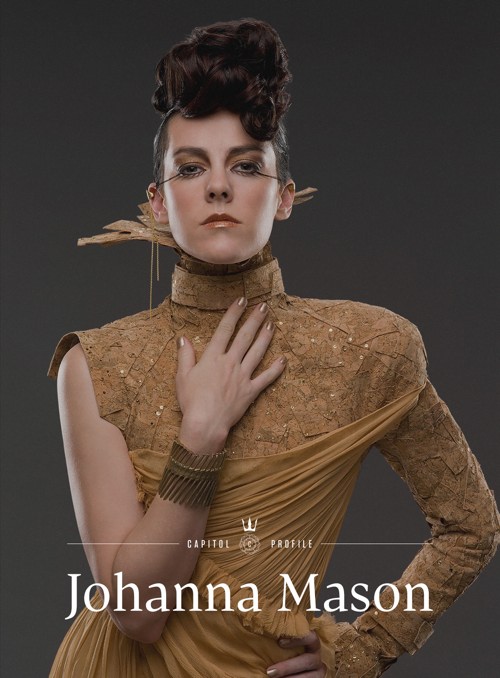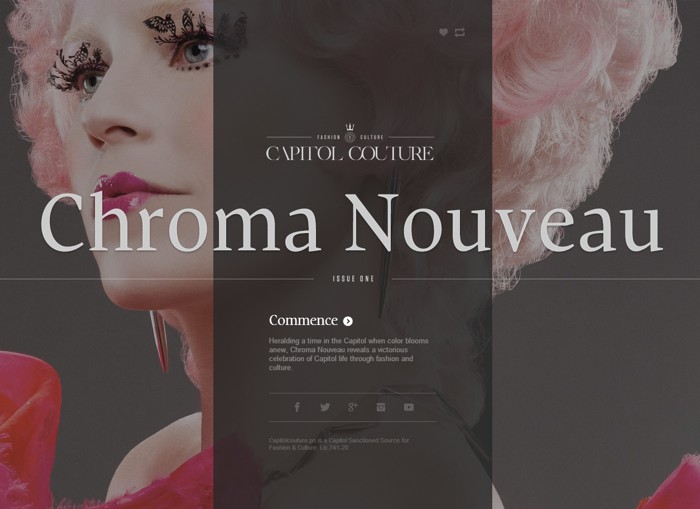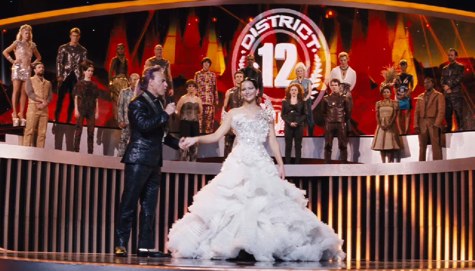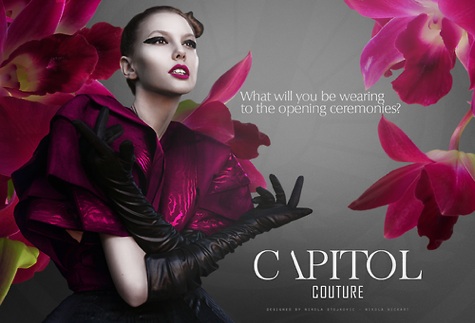It has been reported that as part of the viral marketing campaign surrounding the Hunger Games film sequel Catching Fire, a “luxury clothing line” called Capitol Couture will be released this fall. The line will feature 16 pieces from high-end designer Trish Summerville, all of them meant to reflect the outrageous fashion trends of Panem’s rich and privileged.
A luxury clothing line. I’m sorry, what is the Capitol meant to stand for in Suzanne Collins’ trilogy again? Hang on, it’s coming back to me…
Bear with me for some fashion talk. I promise, it’s pretty intriguing stuff.
So far the viral marketing for Catching Fire has been superb, even better than the work that went into the previous film’s campaign. There are websites devoted to couture spreads of each of the Quarter Quell champions, advertising them much in the way that you would expect the Capitol to—treating the former victors as assets in promotion, viewing them as canvases rather than people. It’s frighteningly real, which is why it’s jarring; if the Hunger Games were an activity that the world participated in, it wouldn’t be hard to imagine real ads and websites just like the ones being created for Catching Fire.
Asking actual fashion designers to contribute their visions to the project is inspired. It lends real credibility to the exercise, and it’s plain logical; you can’t ask a marketing department to design clothes and shoes, after all. What’s more, the designers asked to participate in these campaigns run the gamut—there have been world-famous contributors (Alexander McQueen and Dior have been heavily featured) and newer names who have something unique to bring to the party.

However, the Capitol Couture website is a test for those trying to find the line between reality and fiction. Within the profile article about Johanna Mason, actual designer Jan Taminiau gives this quote: “I love creating a fantasy around a woman’s body,” a reference to the tree-like garb he has her swathed in. Is this a true comment from the designer about the process of creating her look for the photoshoots and film, or something slipped in there by the author of the fake article to give the piece authenticity? Isn’t the point that we can’t really tell?
And that is exactly where the problem lies. With this much blurring between the world of the film and our own, I have to ask: How could anyone possibly feel good about shopping the Capitol Couture line? What are we saying if we buy these clothes—aren’t we buying into the very thing that Suzanne Collins’ books are trying to warn us against? It was bad enough last year with the Capitol-inspired nail polish line from the previous film’s release; at least wearing a specific color nail polish doesn’t do much by way of visually supporting the Capitol’s lifestyle. But wearing clothes with designs specifically derived from that society’s ethics and hollow glamor are inclined to make a different sort of visual impression.
Where fashion and fiction intersect is a fascinating subject; often fantasy worlds are populated with clothing that we subliminally recognize according to more recent history. While Star Wars characters are presumably wearing clothes from another galaxy, it is all too easy to look at Luke, Leia, and Han and say, “They look so 70s!” Because with their hair parted at the center and the v-necklines, there are plenty of cues that make it oh-so-clear when the film was made. Doctor Who is another great example of this trend; despite how oddball many of his costumes seem these days, the fashion choices of most Doctors are right in line with the years of their tenure.

Capitol Couture is meant to do something different—to be ahead of the curve, as outrageous as the overfed, over-stimulated, undereducated Capitol citizens are in the novels. And it’s intriguing that designers are partnering with the film as an excuse to push the envelope of what they can do, certainly. It’s also disturbing that this trilogy, which stands firmly against everything the Capitol creates and glorifies, is the inspiration behind such luxury items.
The chief marketing officer of Lionsgate was quoted saying that Capitol Couture “quickly became an out-of-world experience for both fans of the franchise and those obsessed with the future of fashion.” So let’s strip that comment down for examination: the suggestion is that the “future of fashion” might closely mirror what the Capitol hath wrought. That the bombastic consumerism and disregard for human life that they happily engage in is something that we should be fostering in the here and now by committing ourselves wholeheartedly to image over substance. It’s amazing when a creative work fosters so much more creativity in its wake, but there are times when some distance is dearly needed. That no one working to create these clothes is calling that out the irony of what they’re playing into makes the whole ploy more disturbing.
It’s just a harmless bit of fun, surely! we all want to say. Just because the books are doling out the opposite message doesn’t mean that the fans shouldn’t have their jewel-encrusted cake and eat all twelve tiers! I would love to agree with that, and in most cases I would. And no, we’re not sitting at home watching games that pit children against each other to the death, but here’s a question—where are these clothes being made, I wonder? Will they be lovingly sown by people of an appropriate age, who are making a decent living wage? Because clothing manufacture isn’t known to be the most humane business out there. And what about the cost of such “luxury items”? These are meant to be couture clothes. They will likely be expensive, much more than the teens and (mostly) lower-to-middle-class adults who adore the series can afford.
So in effect, this line of clothing is promoting the same disdain for those who have less—or none—that the Capitol citizens show for those occupying the numbered districts of Panem.

People who have zero interest in fashion may scoff at all of this regardless, but it doesn’t change the fact that clothes communicate. The Hunger Games Trilogy itself acknowledges this: Cinna’s designing of Katniss and Peeta are what make them a focal point in the Games, their costuming arguably one of the most important elements in keeping them alive. Fashion is used to exploit the tributes, and the slavish manner that Capitol citizens adhere to its trends show readers and viewers just how far removed they are from their own reality. It’s not surprising that clothing is an integral part of Collins’ world; what you wear tells people a story, it conveys how you want to be perceived, how you feel and what you think.
What are you communicating to the world if you decide to dress up like a denizen from the Capitol of Panem in your day-to-day life? Is being part of the “future of fashion” really worth associating yourself with those ideals?
The answer to that question, I hope, is an obvious one.
Emmet Asher-Perrin is only too happy to wear some laser-cut leather… but not if it means buying into Effie Trinket’s lifestyle. You can bug her on Twitter and read more of her work here and elsewhere.











I have a problem in general with these films. I loved the books, but I have been hesitent about seeing them turned into movies from the beginning. Suzanne Collins writes often about violence and its impact on the young (her first series, Gregor the Overlander, and obviously the Hunger Games trilogy). I felt that one of the core tenets of the books was the impact violence has on young people forced to experience it, and its use as a means of entertainment for the masses. Never did I get the sense that these were good things. Yet now, the movies come out and millions of people go to see them, many of whom will not get that message, only going to see a big action flick with violence. Once the movies are making money because of the action (and often the violence), of course someone would take the next step and try to make money off spinoffs like Capitol fashion. It’s sad, but inevitable.
And then there’s this.
The buy-in here is horrific, but the books themselves predict it. The Capitol is the way it is because its people like it that way. The people in the books are not any stupider or more self-absorbed than we are in real life.
You touch somewhat on what seems like the point to me: the Districts exist right now. We call them things like Indonesia and Iraq and Bangladesh and Ghana. The first world is the Capitol, living large on the systematic enslavement, torture and murder of people across the rest of the world. And by and large we simply do not care because we are so very fabulous.
It’s very much like the people who throw Gatsby parties. Did they miss the message? Or did they just hear a different one?
It’s one thing to have the designs and the marketing as part of the viral campaign to promote the movie – that’s extending the satire and commentary of the story. But to actually produce the line for sale? That’s *becoming* The Capitol, not mocking it or warning against it. Auctioning off the prototypes for the photo sessions for a charity that feeds hungry people would be the more appropriate thing to do.
I think it’s impossible to show glamorous evil on film without, well, glamorizing it. It’s exactly like the people having Great Gatsby themed parties: sure there was supposed to be an anti-excess message in there somewhere, but if you show a bunch of beautiful people in beautiful outfits on screen at least some people are going to want to emulate them.
I like to think it is deep stealth. Like “hey wait a minute, the oppressive overlords in this dystopia sure seem like fabulously wealthy Americans. HUH HOW ABOUT THAT.”
What little I’ve seen of the clothes makes me think of armour. The people of the Capitol play a deadly game, and their clothes are part of their arsenal.
Perhaps we can use the clothes to single out those who see this as an ideal to be emulated.
I remember thinking along these lines when Watchmen came out in theaters and Silk Specter was sexily splayed on the cover of Maxim (or GQ or some guy magazine). All I could think was “wow… everyone is totally missing the point…”.
@@@@@ 3. chaosprime, extremely well said. Bravo.
Well… the most successful of cosplayer charity groups are the Galactic Empire-themed associations of Star Wars like the 501st and such…
So, while Star Wars is an exploration of finding the freedom of the Galaxy, should all those fans be criticized for wearing the colors of the baddies?
Of course they might, but nobody does it.
The books are saved from much of the glorification of the fashion by being so relentlessly tied to Katness’s POV. She finds the clothes, and the results of the rest of the fashion manipulation, to be beautiful, but also utterly alien to her life.
How many modern teenage girls, tempted by the fashions of the movie, would also be happy, as Katness was, when her body hair grew back after the Capitol makeover artests waxing it all away?
The loss of that perspective in the movies, of the fashion being both resented and used by Katness to survive, a symbol of her murder, is an important loss.
The books see Katness, slave and murder victem, looking out at the Capitol. The movies have too much of the Capitol looking at her, instead.
What is up with people?
The magazine is only a bit of fun people have had ideas for. Why go crazy with superstitions and stuff over the clothing line?
I do not share the article’s author’s concern, at all. What exactly are you implying? That wealth and luxury are inherently bad things, and never, ever should they be in any way glorified? I strongly disagree.
With all due respect, I believe you’re falling into a manichaean stance. The Capitol does some bad things, then they’re bad, therefore everything they do is bad, even something as harmless as an obssession with fancy attires. I am not claiming luxury to be virtuos in any way, just pointing out that is not the opposite either. It just is.
The chief marketing officer of Lionsgate was quoted saying that Capitol Couture “quickly became an out-of-world experience for both fans of the franchise and those obsessed with the future of fashion.”
I think you’re reading too much into this. He explicitely specified he considered it the future of fashion. It is a gigantic jump to go from that to social and moral values. And frankly, I have always been strongly against the notion that the so called excesses of the might and wealthy are somehow evil or decadent.
Not to say I would participate of such a lifestyle, and I will stress I have zero interest in clothing culture or this marketing project. But frankly, and meaning no offense, you’re arguments strike me as too fatalists and overly judgemental.
Just my two cents.
First, well said, Gwydden!
Second, the Capitol Couture clothing line will not actually be couture. It’s a RTW line with many wearable, accessible pieces made to fit and look good on a variety of body types.
Frankly, we need this type of collection. It represents the very message I try to convey on my blog: that geek fashion needs more than some illustrated depiction of your fandom slapped onto a t-shirt. This is something that has upset me for the longest time. I am a geek. I also happened to have graduated from FIT with a BFA in women’s sportswear, was mentored by Carolina Herrera, interned at Michael Kors, and even shared my experiences on the school’s blog, called, coincidentally, ” the Future of Fashion.”
Given my experiences, I’ve always taken the term to refer to the designers behind the clothes. We-the design students- are the future of fashion…. Personally, I come from nothing, still live in a tiny closet of a space, and believe that I’ll someday profit off my Capitol-worthy designs and eventually get to experience the lifestyle. I don’t think I’m an evil person for wanting this. Let the fans ooh and ahh, and want a piece of the Capitol. We all want, and we want it all.
Third, fashion is supposed to be FUN! Don’t take it so seriously. How do you read so far into fantastical, whimsical costumes? These people aren’t dumb. They recognize that life is too short to NOT cover your head in butterflies one day. Wear ALL the colors! Rejoyce in that they will soon become attainable.
And what of the price? Has being a geek always been the cheepest thing? How much money do cosplayers spend? How expensive are gaming consoles? Designer toy collecting? If a geek wants to drop, what, $500 on a PS4, and then decides to invest in a wardrobe staple or two that will hang in their closet for years to come instead, who are you to judge? I, for one, will applaude them.
bad clothing how much make up dose the capitol couture need
The clothing worn in the Capitol is specifically chosen to be garish and excessive to the point of invoking annoyance in the viewer. Luxury isn’t necessarily a bad thing, but it comes off as an eye-opener when you compare their clothing to those of the Districts. The clothing of the Capitol isn’t just a fancy little quirk the author provided, it’s an actual prop to make those residents come across as even more ridiculous.
Their clothing has become, in my opinion, iconic to that sycophantic theme. Producing an actual clothing line of a prop intentionally attached to so many social themes is exactly that. Trying to rationalize it by untying the social themes from it is like trying to give another person the middle finger and pretending it no longer has any negative connotations.
Hunger Games is not just some rant against rich people who can afford cool clothes, it’s an actual dialogue and symbol of what is already occuring today. If you’re caring more about the “ooh and aah” then you completely missed the point.